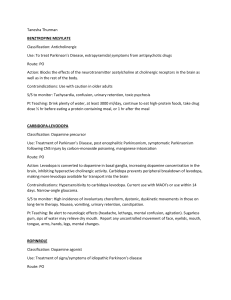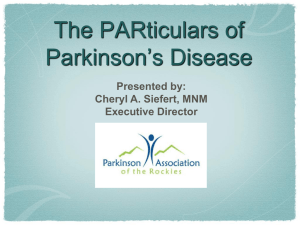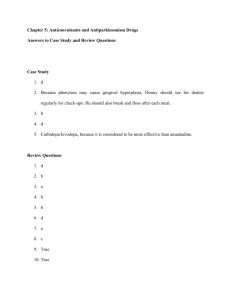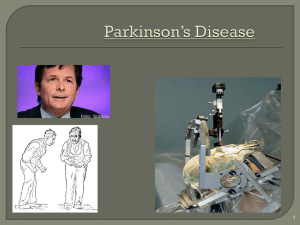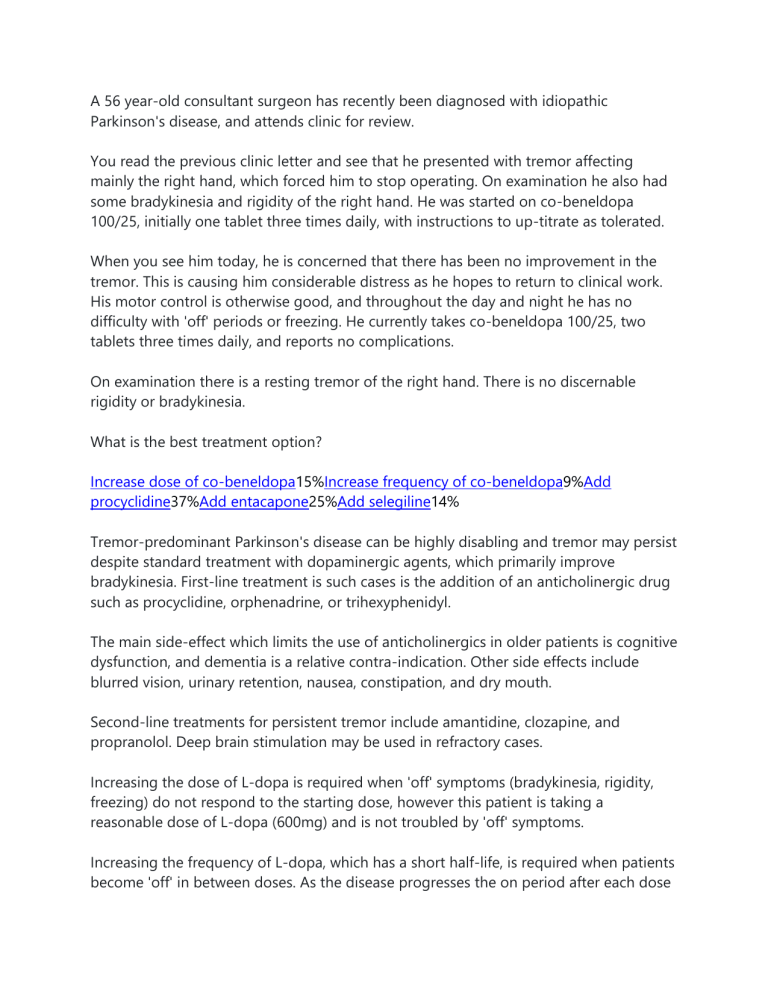
A 56 year-old consultant surgeon has recently been diagnosed with idiopathic
Parkinson's disease, and attends clinic for review.
You read the previous clinic letter and see that he presented with tremor affecting
mainly the right hand, which forced him to stop operating. On examination he also had
some bradykinesia and rigidity of the right hand. He was started on co-beneldopa
100/25, initially one tablet three times daily, with instructions to up-titrate as tolerated.
When you see him today, he is concerned that there has been no improvement in the
tremor. This is causing him considerable distress as he hopes to return to clinical work.
His motor control is otherwise good, and throughout the day and night he has no
difficulty with 'off' periods or freezing. He currently takes co-beneldopa 100/25, two
tablets three times daily, and reports no complications.
On examination there is a resting tremor of the right hand. There is no discernable
rigidity or bradykinesia.
What is the best treatment option?
Increase dose of co-beneldopa15%Increase frequency of co-beneldopa9%Add
procyclidine37%Add entacapone25%Add selegiline14%
Tremor-predominant Parkinson's disease can be highly disabling and tremor may persist
despite standard treatment with dopaminergic agents, which primarily improve
bradykinesia. First-line treatment is such cases is the addition of an anticholinergic drug
such as procyclidine, orphenadrine, or trihexyphenidyl.
The main side-effect which limits the use of anticholinergics in older patients is cognitive
dysfunction, and dementia is a relative contra-indication. Other side effects include
blurred vision, urinary retention, nausea, constipation, and dry mouth.
Second-line treatments for persistent tremor include amantidine, clozapine, and
propranolol. Deep brain stimulation may be used in refractory cases.
Increasing the dose of L-dopa is required when 'off' symptoms (bradykinesia, rigidity,
freezing) do not respond to the starting dose, however this patient is taking a
reasonable dose of L-dopa (600mg) and is not troubled by 'off' symptoms.
Increasing the frequency of L-dopa, which has a short half-life, is required when patients
become 'off' in between doses. As the disease progresses the on period after each dose
becomes shorter.
Entacapone and selegiline are used as adjuncts to prolong the 'on' period after a dose
of L-dopa.
Discuss (2)Improve
Next question
Parkinson's disease: management
Parkinsons disease should only be diagnosed, and management initiated, by
a specialist with expertise in movement disorders. However, it is important for all
doctors to be aware of the medications used in Parkinson's given the prevalence of this
condition. NICE published guidelines in 2017 regarding the management of Parkinson's
disease.
For first-line treatment:
if the motor symptoms are affecting the patient's quality of life: levodopa
if the motor symptoms are not affecting the patient's quality of life: dopamine
agonist (non-ergot derived), levodopa or monoamine oxidase B (MAO-B)
inhibitor
Whilst all drugs used to treat Parkinson's can cause a wide variety of side-effects NICE
produced tables to help with decision making:
Motor symptoms
Levodopa
Dopamine agonists
MAO-B inhibitors
More improvement in motor
symptoms
Less improvement in motor
symptoms
Less improvement in motor
symptoms
Activities of daily More improvement in
activities of daily living
living
Less improvement in activities Less improvement in activities
of daily living
of daily living
Motor
complications
More motor complications
Fewer motor complications
Fewer motor complications
Adverse events
Fewer specified adverse
events*
More specified adverse
events*
Fewer specified adverse
events*
* excessive sleepiness, hallucinations and impulse control disorders
If a patient continues to have symptoms despite optimal levodopa treatment or has
developed dyskinesia then NICE recommend the addition of a dopamine agonist,
MAO-B inhibitor or catechol-O-methyl transferase (COMT) inhibitor as an adjunct.
Again, NICE summarise the main points in terms of decision making:
Dopamine agonists
MAO-B inhibitors
Improvement in
motor symptoms
Improvement in
motor symptoms
Improvement in
motor symptoms
No evidence of
improvement in motor
symptoms
Improvement in
Activities of daily
activities of daily
living
living
Improvement in
activities of daily
living
Improvement in
activities of daily
living
No evidence of
improvement in activities
of daily living
Off-time reduction
No studies reporting this
outcome
Motor symptoms
COMT inhibitors
Amantadine
Off time
More off-time
reduction
Off-time reduction
Adverse events
Intermediate risk of
adverse events
Fewer adverse events More adverse events
No studies reporting this
outcome
Hallucinations
More risk of
hallucinations
Lower risk of
hallucinations
No studies reporting this
outcome
Lower risk of
hallucinations
Specific points regarding Parkinson's medication
NICE reminds us of the risk of acute akinesia or neuroleptic malignant syndrome if
medication is not taken/absorbed (for example due to gastroenteritis) and advise
against giving patients a 'drug holiday' for the same reason.
Impulse control disorders have become a significant issue in recent years. These can
occur with any dopaminergic therapy but are more common with:
dopamine agonist therapy
a history of previous impulsive behaviours
a history of alcohol consumption and/or smoking
If excessive daytime sleepiness develops then patients should not drive. Medication
should be adjusted to control symptoms. Modafinil can be considered if alternative
strategies fail.
If orthostatic hypotension develops then a medication review looking at potential
causes should be done. If symptoms persist then midodrine (acts on peripheral alphaadrenergic receptors to increase arterial resistance) can be considered.
Consider glycopyrronium bromide to manage drooling of saliva in people with
Parkinson's disease.
Further information regarding specific anti-Parkinson's medication
Levodopa
nearly always combined with a decarboxylase inhibitor (e.g. carbidopa or
benserazide)
o this prevents the peripheral metabolism of levodopa to dopamine outside
of the brain and hence can reduce side effects
common adverse effects:
o dry mouth
o anorexia
o palpitations
o postural hypotension
o psychosis
some adverse effects are due to the difficulty in achieving a steady dose of
levodopa
o end-of-dose wearing off: symptoms often worsen towards the end of
dosage interval. This results in a decline of motor activity
o 'on-off' phenomenon: large variations in motor performance, with normal
function during the ‘on’ period, and weakness and restricted mobility
during the ‘off’ period
o dyskinesias at peak dose: dystonia, chorea and athetosis (involuntary
writhing movements)
o these effects may worsen over time with - clinicians therefore may limit
doses until necessary
it is important not to acutely stop levodopa, for example, if a patient is admitted
to hospital
o
if a patient with Parkinson's disease cannot take levodopa orally, they can
be given a dopamine agonist patch as rescue medication to prevent acute
dystonia
Dopamine receptor agonists
e.g. bromocriptine, ropinirole, cabergoline, apomorphine
ergot-derived dopamine receptor agonists (bromocriptine, cabergoline) have
been associated with pulmonary, retroperitoneal and cardiac fibrosis. The
Committee on Safety of Medicines advice that an echocardiogram, ESR,
creatinine and chest x-ray should be obtained prior to treatment and patients
should be closely monitored
patients should be warned about the potential for dopamine receptor agonists to
cause impulse control disorders and excessive daytime somnolence
more likely than levodopa to cause hallucinations in older patients. Nasal
congestion and postural hypotension are also seen in some patients
MAO-B (Monoamine Oxidase-B) inhibitors
e.g. selegiline
inhibits the breakdown of dopamine secreted by the dopaminergic neurons
Amantadine
mechanism is not fully understood, probably increases dopamine release and
inhibits its uptake at dopaminergic synapses
side-effects include ataxia, slurred speech, confusion, dizziness and livedo
reticularis
COMT (Catechol-O-Methyl Transferase) inhibitors
e.g. entacapone, tolcapone
COMT is an enzyme involved in the breakdown of dopamine, and hence may be
used as an adjunct to levodopa therapy
used in conjunction with levodopa in patients with established PD
Antimuscarinics
block cholinergic receptors
now used more to treat drug-induced parkinsonism rather than idiopathic
Parkinson's disease
help tremor and rigidity
e.g. procyclidine, benzotropine, trihexyphenidyl (benzhexol)
Image sourced from Wikipedia
Diagram showing the mechanism of action of Parkinson's drugs
A 45-year-old woman comes to the clinic some 6 months after thyroid resection for
differentiated thyroid cancer. She is well, has recovered from her surgery and has a
neatly healed scar across her anterior neck. Blood pressure is normal at 110/80 mmHg,
and her pulse is 60 and regular. Her body mass index is unchanged at 25 kg/m². Only
medication is thyroid hormone replacement.
Which of the following is the most appropriate way to monitor for a recurrence?
MRI neck1%Technetium scanning7%Thyroglobulin82%Thyroid ultrasound scan6%T3
levels4%
Given this patient is prescribed thyroid hormone replacement, monitoring of T3 or T4 is
not useful in monitoring for cancer recurrence. On the other hand the presence of
thyroglobulin does indicate thyroid gland activity which isn't suppressed by thyroid
hormone replacement and is therefore potentially cancerous in origin. Levels should be
undetectable.
Radiological investigations such as MRI neck, technetium scanning or thyroid ultrasound
scanning are potentially less sensitive than monitoring for thyroglobulin and are
therefore not a preferred first line investigation. T3 levels are unsuitable as a marker of
recurrence given that conversion of exogenously administered T4 to T3 confounds any
measurement.
Discuss (2)Improve
Next question
Thyroid cancer
Features of hyperthyroidism or hypothyroidism are not commonly seen in patients with
thyroid malignancies as they rarely secrete thyroid hormones
Main points
Type
Percentage
Papillary
70%
Often young females - excellent prognosis
Follicular
20%
Medullary
5%
Cancer of parafollicular (C) cells, secrete calcitonin, part of MEN-2
Anaplastic
1%
Not responsive to treatment, can cause pressure symptoms
Lymphoma
Rare
Associated with Hashimoto's thyroiditis
Management of papillary and follicular cancer
total thyroidectomy
followed by radioiodine (I-131) to kill residual cells
yearly thyroglobulin levels to detect early recurrent disease
Further information
Type
Papillary
carcinoma
Follicular
adenoma
Follicular
carcinoma
Medullary
carcinoma
Notes
Usually contain a mixture of papillary and colloidal filled follicles
Histologically tumour has papillary projections and pale empty nuclei
Seldom encapsulated
Lymph node metastasis predominate
Haematogenous metastasis rare
Usually present as a solitary thyroid nodule
Malignancy can only be excluded on formal histological assessment
May appear macroscopically encapsulated, microscopically capsular invasion is seen.
Without this finding the lesion is a follicular adenoma.
Vascular invasion predominates
Multifocal disease raree
C cells derived from neural crest and not thyroid tissue
Serum calcitonin levels often raised
Familial genetic disease accounts for up to 20% cases
Both lymphatic and haematogenous metastasis are recognised, nodal disease is associated
with a very poor prognosis.
Type
Anaplastic
carcinoma
Notes
Most common in elderly females
Local invasion is a common feature
Treatment is by resection where possible, palliation may be achieved through
isthmusectomy and radiotherapy. Chemotherapy is ineffective.
A 40-year-old lady presents with dyspnoea. She describes a gradual onset of shortness
of breath on exercise over several months. She has a past medical history of wheeze as
an infant. She has recently commenced a intranasal steroid spray for rhinitis. She is a
non-smoker.
On examination she has oxygen saturations of 91% on air. She has blood stained
crusting around her anterior nares. On auscultation her chest has bilateral reduced air
entry and coarse crepitations on both lung bases. Her temperature is 37.8 degrees
centrigrade.
Hb
13.2 g/dL
WCC
10.3 *10^9/l
Neutrophil
7.8 *10^9/l
Eosinophil
0.07 *10^9/l
Sodium
135 mmol/l
Potassium
4.5 mmol/l
Creatinine
113 µmol/l
Urea
5.4 mmol/l
CRP
230 mg/L
Chest X - ray
Bilateral basal consolidation
Urine microscopy
Culture negative
RBC +++ WCC +
c-ANCA
Positive
p-ANCA
Positive
Anti-GBM
Negative
What is the most likely diagnosis?
Pneumonia0%Churg-Strauss Syndrome21%Microscopic polyangiitis14%Granulomatosis
with polyangiitis63%Goodpastures disease2%
Consider granulomatosis with polyangiitis when a patient presents with ENT, respiratory
and kidney involvement
Important for meLess important
Definitive diagnosis of vasculitis will require biopsy. However, granulomatosis with
polyangiitisis the most likely as the presentation includes sinus disease, lung disease
with likely renal involvement. Both ANCA tests can be positive but it is most associated
with c-ANCA.
This patient had wheeze as a child, which is very common. Churg-Strauss is more
associated with a progressive presentation of asthma, which may present later in life.
The patient also does not have eosinophilia which is associated with this diagnosis.
Goodpasture's is a possibility but less likely with a negative anti-GBM. Pnemonia is less
likely with such a prolonged presentation.
Microscopic polyangiitis can present very similar to granulomatosis with polyangiitis but
is more associated with renal involvement, which is mild in this case. It is less associated
with ENT disease.
Discuss (2)Improve
Next question
Granulomatosis with polyangiitis
Granulomatosis with polyangiitis is now the preferred term for Wegener's
granulomatosis. It is an autoimmune condition associated with a necrotizing
granulomatous vasculitis, affecting both the upper and lower respiratory tract as well as
the kidneys.
Features
upper respiratory tract: epistaxis, sinusitis, nasal crusting
lower respiratory tract: dyspnoea, haemoptysis
rapidly progressive glomerulonephritis ('pauci-immune', 80% of patients)
saddle-shape nose deformity
also: vasculitic rash, eye involvement (e.g. proptosis), cranial nerve lesions
Comparison of granulomatosis with polyangiitis and Churg-Strauss syndrome
Investigations
cANCA positive in > 90%, pANCA positive in 25%
chest x-ray: wide variety of presentations, including cavitating lesions
renal biopsy: epithelial crescents in Bowman's capsule
Management
steroids
cyclophosphamide (90% response)
plasma exchange
median survival = 8-9 years
A 44 year old female patient is admitted to the oncology ward to undergo
chemotherapy for Diffuse Large B-Cell lymphoma stage IVb. She had originlly presented
to her GP with intermittent abdominal bloating and constipation and occasional
shortness of breath. She also reported having to often get up in the middle of the night
to change the bed clothes due to drenching sweats. Her GP had been concerned by
these symptoms and had organised an immediate chest X-ray to be undertaken at the
nearby hospital.
Chest X-ray
large mediastinal mass with clear lung fields.
On receiving this report the GP arranged an urgent appointment with a local
haematologist as he suspected that the patient was suffering from lymphoma. She was
seen only 4 days later. Given the clinical history the team at the hospital arranged some
urgent investigations.
Hb
9.5 g/dl
Platelets
140 * 109/l
WBC
36.5 * 109/l
Lactate Dehydrogenase
2540IU/l
CT-guided Lymph node biopsy
cells are large, with prominent nucleoli and abundant cytoplasm and many
mitoses expressing CD19 and CD20 markers
PET scan
large extra-nodal disease bulks most notable in the ileo-caecal area and in the
mediastinum. Overall bulky disease in keeping with the diagnosis of advanced
stage lymphoma.
The patient is admitted to receive cycle one of R-CHOP chemotherapy under close
monitoring.
What electrolyte abnormalities would suggest tumour lysis syndrome?
High Potassium, high Calcium, low Phosphate14%Low Potassium, high Calcium, low
Phosphate3%High Potassium, low Calcium, high Phosphate81%Low Potassium, low
Calcium, high Phosphate2%Low Potassium, low Calcium, low Phosphate0%
Discuss (9)Improve
Next question
Tumour lysis syndrome
Tumour lysis syndrome (TLS) is a potentially deadly condition related to the treatment of
high-grade lymphomas and leukaemias. It can occur in the absence of chemotherapy
but is usually triggered by the introduction of combination chemotherapy. On occasion,
it can occur with steroid treatment alone. Awareness of the condition is critical as
prophylactic medication can be given to prevent the potentially deadly effects of
tumour cell lysis.
TLS occurs from the breakdown of the tumour cells and the subsequent release of
chemicals from the cell. It leads to a high potassium and high phosphate level in the
presence of a low calcium. It should be suspected in any patient presenting with an
acute kidney injury in the presence of a high phosphate and high uric acid level.
Prevention
IV fluids
patients are higher risk should receive either allopurinol or rasburicase
rasburicase
a recombinant version of urate oxidase, an enzyme that metabolizes uric
acid to allantoin. Allantoin is much more water-soluble than uric acid and
is, therefore, more easily excreted by the kidneys
o generally preferred now for patients at a higher risk of developing TLS
allopurinol
o generally used for patients in lower-risk groups
rasburicase and allopurinol should not be given together in the management of
tumour lysis syndrome as this reduces the effect of rasburicase
o
From 2004 TLS has been graded using the Cairo-Bishop scoring system Laboratory tumor lysis syndrome: abnormality in two or more of the following, occurring
within three days before or seven days after chemotherapy.
uric acid > 475umol/l or 25% increase
potassium > 6 mmol/l or 25% increase
phosphate > 1.125mmol/l or 25% increase
calcium < 1.75mmol/l or 25% decrease
Clinical tumor lysis syndrome: laboratory tumour lysis syndrome plus one or more of the
following:
increased serum creatinine (1.5 times upper limit of normal)
cardiac arrhythmia or sudden death
seizure

